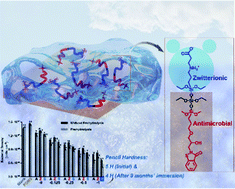Sol–gel-derived hard coatings from tetraethoxysilane and organoalkoxysilanes bearing zwitterionic and isothiazolinone groups and their antifouling behaviors†
Abstract
Current environmentally friendly marine antifouling (AF) coatings are mainly polymeric with a relatively low hardness. Hard sol–gel-derived AF coatings for underwater robot-cleaning are seldom used. In this work, two new organoalkoxysilanes, i.e., (N-methoxyacylethyl)-3-aminopropyltriethoxysilane and 2-(2-hydroxy-3-(3-(trimethoxysilyl)propoxy)propyl)benzo[d]isothiazol-3(2H)-one, were synthesized by a facile method. These two precursors were used with tetraethoxysilane (TEOS) to produce three series of hybrid AF coatings with zwitterionic group (Z-χ), antibacterial group (1,2-benzisothiazolin-3-one) (A-χ) and zwitterionic and antibacterial groups (S-χ) by a sol–gel process. The hardness of the coatings was measured using a pencil hardness tester and the AF behaviors of the coatings were examined by laboratory and field assays. A pencil hardness up to 5 H was achieved and slight deterioration was observed after 9 months of immersion in artificial seawater for the A-χ and S-χ coatings at a sufficiently high TEOS content. A synergistic effect between the zwitterion and antimicrobial agents existed but was not obvious. A higher TEOS content led to a higher hardness and better AF performance regardless of the type of AF group. Even with the same biofilm formation after field assay, coatings with a higher TEOS content exhibited a better resistance to mussel settlement.



 Please wait while we load your content...
Please wait while we load your content...